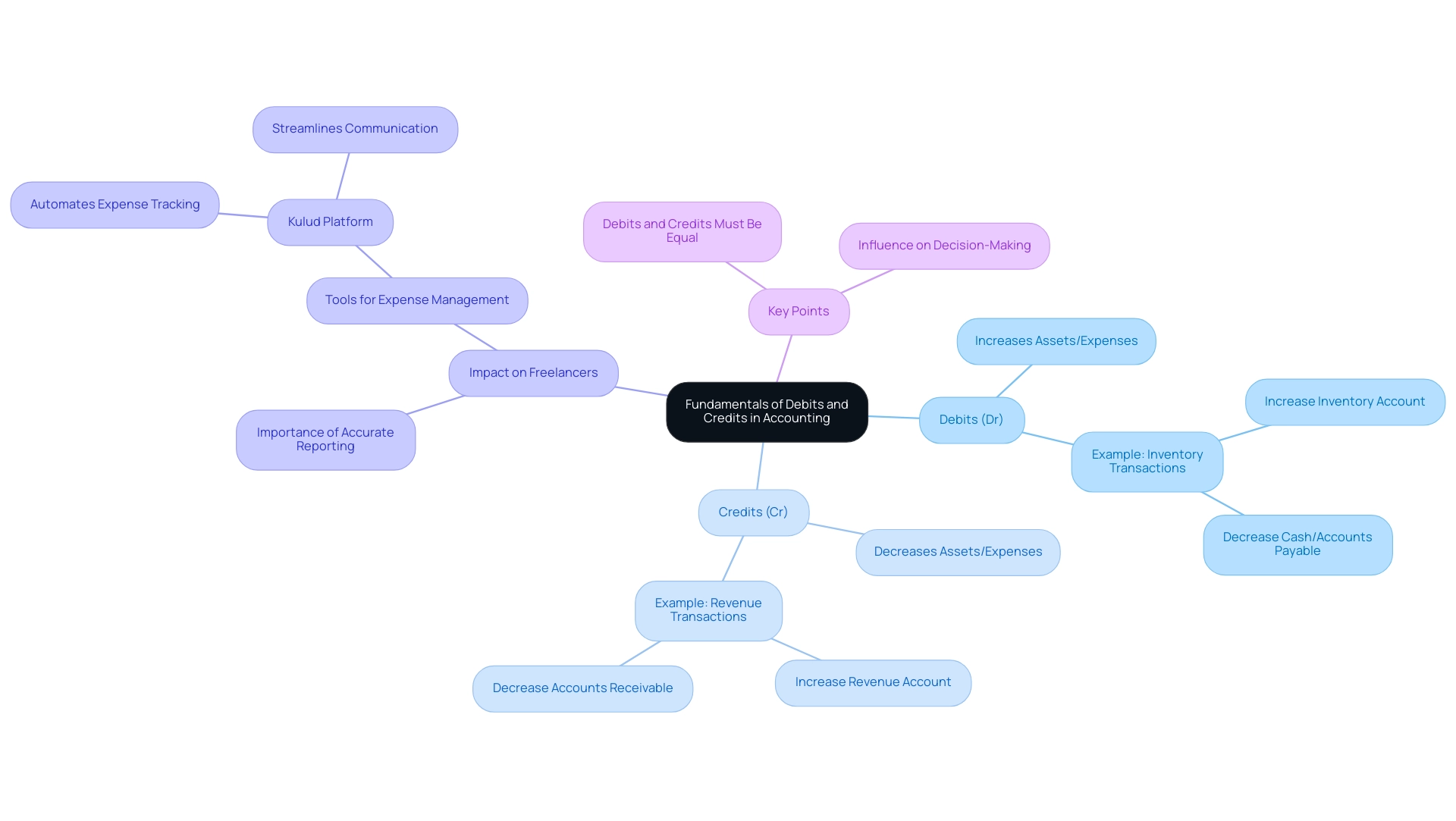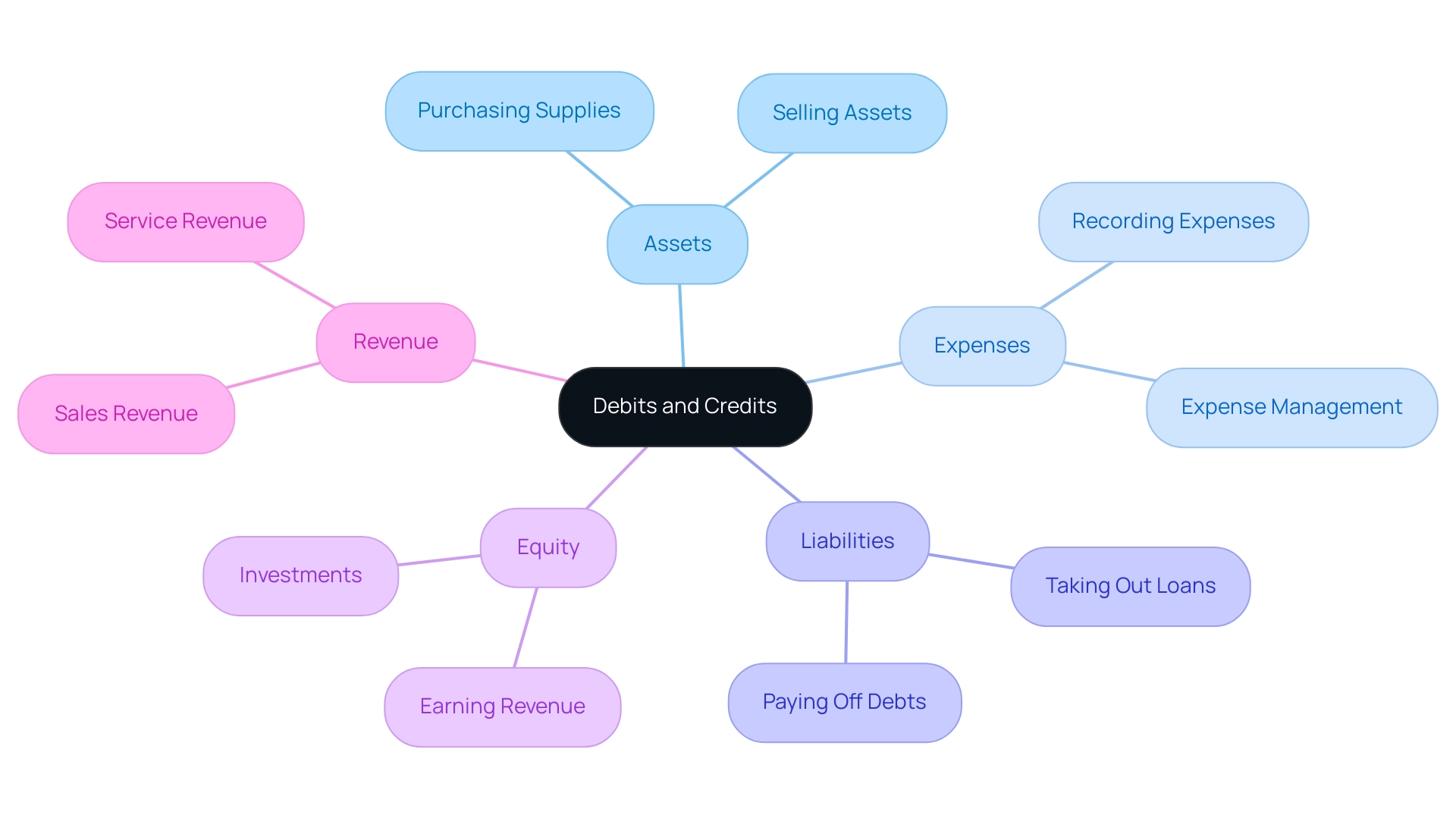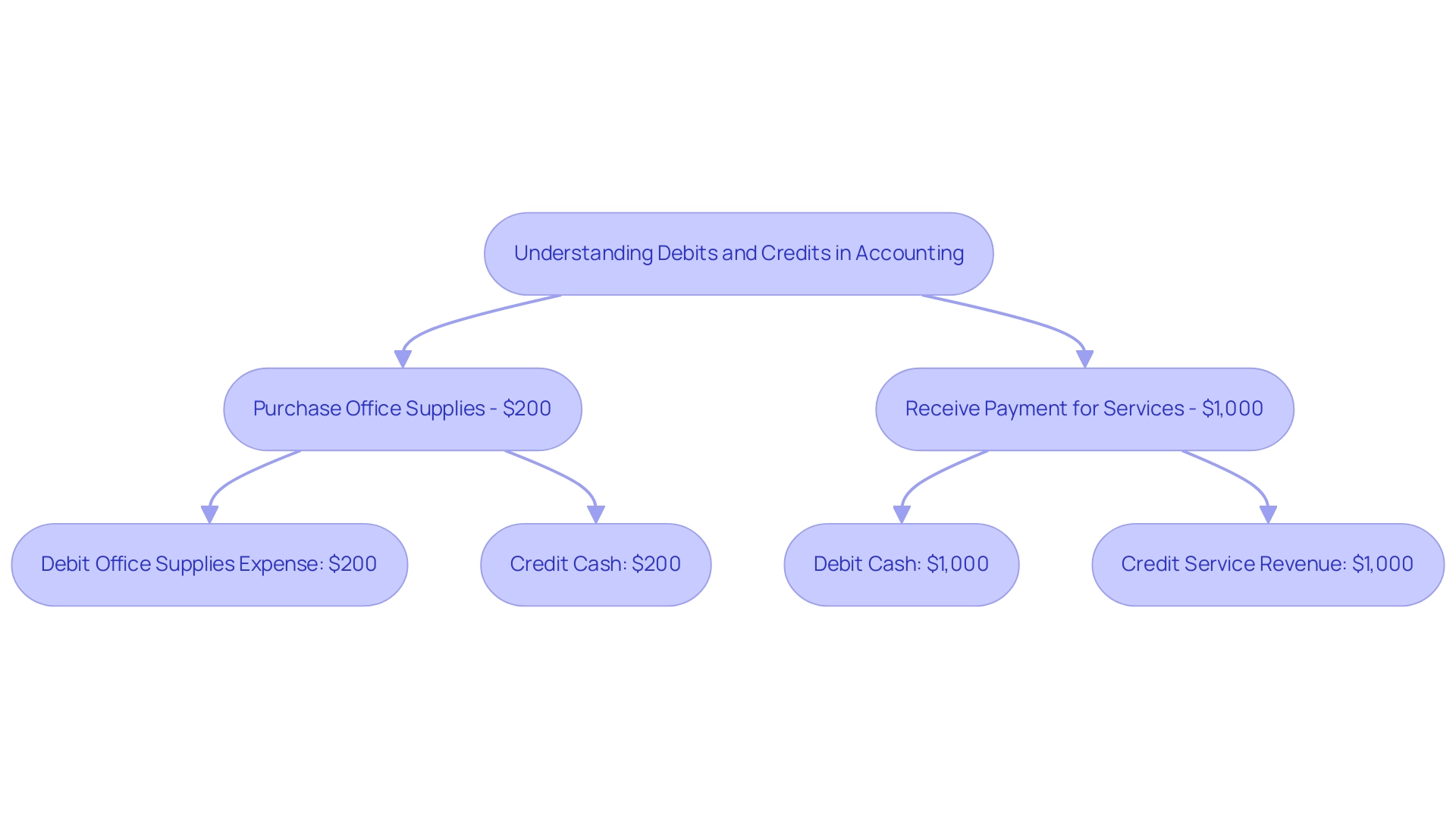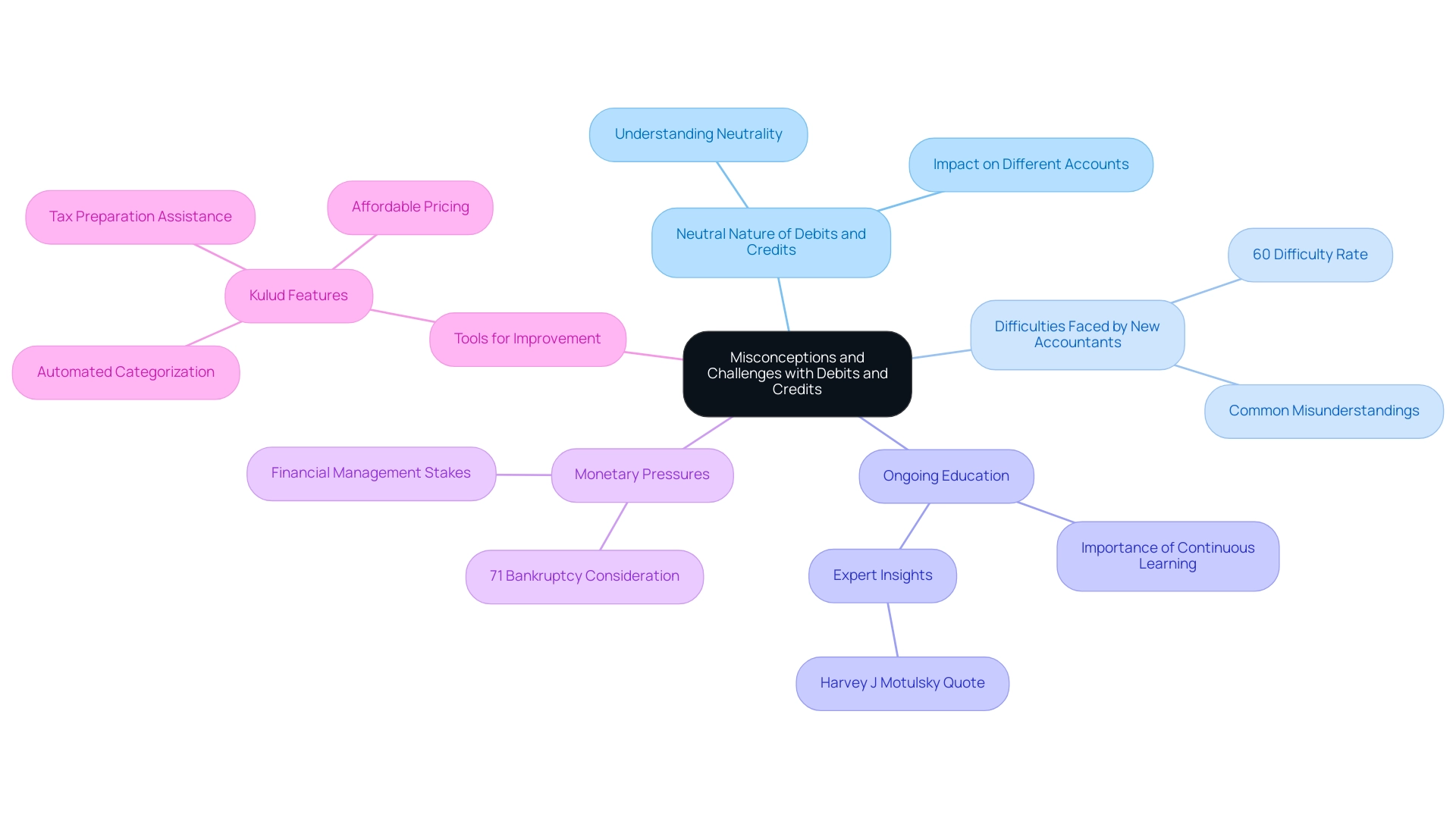Overview
This article seeks to address the common concerns that new accountants and small business owners face regarding the principles of accounting debits and credits. Understanding these concepts is crucial for effective financial management. It clarifies how debits serve to increase asset or expense accounts, while credits lead to their decrease. Mastering these principles is essential for accurate financial reporting and informed decision-making.
Furthermore, practical examples illustrate their application in real-world scenarios. The article also highlights the advantages of utilizing automated tools, such as Kulud, to enhance bookkeeping efficiency. This means that by adopting these practices, individuals can significantly improve their financial management capabilities.
Introduction
In the intricate world of accounting, the concepts of debits and credits serve as the bedrock of financial transactions, shaping how businesses track their financial health. These dual entries not only determine the interactions among assets, expenses, liabilities, and revenues but also play a pivotal role in ensuring the accuracy of financial reporting.
Freelancers and small business owners often face challenges in managing their finances, making an understanding of these principles increasingly vital. Furthermore, with the rise of innovative tools like Kulud, which automates expense management and streamlines bookkeeping, mastering debits and credits can significantly transform business operations.
This article delves into the fundamentals of these accounting concepts, explores common misconceptions, and highlights the essential rules that govern their application. This means that by grasping these concepts, businesses can contribute to their financial success in today's dynamic landscape.
Fundamentals of Debits and Credits in Accounting
In accounting, every financial transaction is grounded in the principles of charges and offsets, which involve accounting debit or credit. An entry, often denoted as 'Dr', signifies a transaction that increases asset or expense accounts, while the accounting debit or credit simultaneously decreases liability, revenue, or equity accounts. Conversely, a transaction, abbreviated as 'Cr', acts as an accounting debit or credit that decreases asset or expense accounts and increases liability, revenue, or equity accounts.
For example, when a company obtains inventory, it increases the inventory account and decreases either cash or accounts payable. This dual-entry system is crucial as it ensures the integrity of the accounting equation: Assets = Liabilities + Equity, which is based on the principles of accounting debit or credit. Recent trends in 2025 highlight the growing importance of understanding these fundamental concepts, especially for freelancers and small business owners who often manage their own finances. Correct usage of charges and payments is crucial for upholding accurate fiscal records, which can greatly influence decision-making and economic reporting.
In fact, key points suggest that withdrawals and deposits must be equal for every transaction, ensuring precise reporting for stakeholders. Statistics indicate that a substantial percentage of accountants—over 80%—recognize the critical role that accounting debit or credit plays in effective financial practices.
The significance of accounting debit or credit extends beyond theoretical knowledge; they are vital for real-world applications in small businesses. Effective expense management platforms like Kulud automate the tracking of these transactions, allowing users to focus on growth rather than getting bogged down in manual bookkeeping. With features such as automated invoice matching, automated categorization of expenses, and the ability to easily request missing invoices, Kulud streamlines the entire expense management process.
Furthermore, Kulud centralizes invoices, receipts, and transactions, providing a comprehensive view of financial data. As Georgia Knyazhev noted, Kulud has a transformative impact on accounting processes, enabling users to save time and enhance communication with their accountants. Additionally, Kulud has successfully passed security evaluations, guaranteeing that user information is managed with the highest level of care and adherence.
Grasping the equilibrium between income and expenses is not merely a technical necessity; it represents a strategic benefit for freelancers and small business proprietors. By mastering these concepts and utilizing tools like Kulud, they can ensure precise reporting, which is essential for attracting stakeholders and making informed business decisions. As the field of finance continues to change, staying knowledgeable about the basics of transactions is essential for success.

Essential Rules for Applying Debits and Credits
The implementation of charges and payments in financial management adheres to fundamental guidelines that are vital for maintaining precise financial documentation. Understanding these principles is crucial for any business, particularly small enterprises that depend on effective bookkeeping practices, including accounting debit or credit. Tools like Kulud enable freelancers to significantly streamline their financial processes.
Awareness of the common concerns freelancers face regarding expense management is essential. In accounting, entries serve to increase asset and expense accounts, while withdrawals reduce them. For instance, when a small business purchases office supplies, it records the supplies expense account, indicating an increase in expenses. Conversely, if the business sells an asset, it records a reduction in the asset account, reflecting a decrease. Kulud simplifies this process by automating the capture of invoices and receipts, allowing users to easily match these with their bank transactions.
Comprehension of liabilities, equity, and revenue accounts reveals that credits increase these accounts, while debits decrease them. For example, when a company takes out a loan, it records the liability account, indicating an increase in obligations. Similarly, when revenue is earned, it is credited to the revenue account, enhancing the business's equity. Kulud's platform allows users to centralize their financial data, making it easier to track these changes in real-time.
Furthermore, a fundamental aspect of financial record-keeping is the double-entry system, which requires that every transaction must have equal entries on both sides to maintain balance. For instance, if a company receives cash from a sale, it debits the cash account and credits the sales revenue account, ensuring that the financial equation remains intact. Kulud enhances this process by providing seamless integration with financial software, enabling efficient data export and reducing the time spent on manual entries.
In 2025, it is projected that more than 70% of small enterprises will employ double-entry record-keeping systems, underscoring its significance in effective resource management. This statistic aligns with the fact that companies like NetSuite have over 41,000 customers relying on their products to fuel growth, emphasizing the critical role of robust financial systems.
Conviction is reinforced by expert guidance, which highlights that adhering to regulations for applying accounting debit or credit is essential for precise reporting and compliance with standards. Recent updates in financial practices have also underscored the importance of transaction objects in managing invoices and payments. A case study titled 'Transaction Objects Example for Payables' illustrates how businesses can effectively manage invoice distributions and related payments, ensuring compliance with financial regulations and accurate financial reporting.
This approach not only streamlines the financial process but also enhances communication with accountants, as noted by users who have experienced transformative changes in their financial practices. Moreover, comprehending the three categories of accounts related to the golden rule of finance—real accounts, nominal accounts, and personal accounts—provides essential context for understanding entries and withdrawals, ensuring that readers grasp the broader framework of financial principles.
In conclusion, mastering the essential principles of accounting debit or credit is crucial for any accountant. As Georgi Knyazhev aptly stated, "Kulud has transformed my financial processes, allowing me to save time and streamline communication with my accountants." This illustrates the wider trend of utilizing technology to enhance task management, allowing businesses to focus on growth while maintaining precise records.
Action is encouraged through user testimonials that highlight how Kulud's automated expense management has transformed bookkeeping from hours to minutes, making it an invaluable tool for freelancers. Additionally, Kulud offers step-by-step instructions for retrieving missing invoices, ensuring that users can easily access all necessary financial documents. Pricing for Kulud begins at €0.15 per invoice after the initial 50 invoices processed each month, presenting a cost-effective solution for freelancers aiming to enhance their financial efficiency.

Real-World Examples of Debits and Credits in Action
To illustrate the application of accounting debit or credit in financial management, consider a common scenario faced by freelancers. When a freelancer purchases office supplies for $200, the transaction is recorded as follows:
- Debit the Office Supplies Expense account for $200, which increases the expense.
- Credit the Cash account for $200, reflecting a decrease in assets.
This straightforward entry highlights how expenses are tracked and managed.
Similarly, when a contractor receives a payment of $1,000 for services rendered, the accounting entry would be:
- Debit the Cash account for $1,000, indicating an increase in assets.
- Credit the Service Revenue account for $1,000, which increases revenue.
These examples not only illustrate the mechanics of accounting debit or credit in recording transactions but also emphasize the significance of maintaining precise records.
In 2025, freelancers and contractors can benefit from understanding average expense categories, such as office supplies, software subscriptions, and travel expenses, which often constitute significant portions of their budgets. By efficiently employing charges and payments, they can simplify their expense monitoring and guarantee that their statements correctly represent their business operations.
Real-world case studies show that many freelancers have successfully applied these principles to improve their money management. For instance, a freelancer who meticulously records each transaction using accounting debit or credit can quickly identify trends in their spending, allowing for improved budgeting and planning. As noted by Thomas H., a user of Kulud, "Matching invoices with transactions used to take hours. With Kulud, it's automated and accurate, saving me and my clients so much time." This illustrates the transformative impact of Kulud's automated expense management platform on accounting efficiency and client collaboration.
Moreover, understanding the challenges small businesses encounter in obtaining affordable capital—where 79% report difficulties—highlights the importance of effective management of resources. Precise record-keeping can lead to improved monetary decisions, which is crucial in a tough lending landscape. As noted by McKinsey, embedded lending is linked to higher profit margins, further emphasizing the advantages of diligent expense management.
Additionally, the rise of digital payment systems provides automated reporting and real-time transaction tracking, simplifying bookkeeping and reducing human errors associated with cash transactions. Kulud's capability to link bank accounts and align expenses with transactions illustrates this automation, appealing to freelancers and contractors seeking to improve their financial practices. Furthermore, with features like the ability to request missing invoices and smart reconciliation, Kulud ensures that users can manage their finances efficiently.
Grasping the subtleties of charges and payments is crucial for freelancers and small business proprietors, as it establishes the basis for efficient financial oversight and aids in managing the intricacies of financial record-keeping.

Common Misconceptions and Challenges with Debits and Credits
A common misunderstanding in accounting is the notion that entries on one side are inherently 'good' while those on the other side are 'bad.' In truth, both accounting debit and credit are neutral, and their effects vary based on the type of account involved. For example, withdrawals enhance asset accounts, which can be viewed favorably, while they reduce liability accounts, which may also be regarded as beneficial in specific situations. This nuanced understanding is crucial for accurate reporting, especially for freelancers and small business owners who rely on precise data to manage their resources effectively.
New accountants often face difficulties in understanding how charges and payments relate to accounting debit or credit for various accounts. A significant percentage of these professionals—estimated at around 60%—report difficulties in applying these concepts correctly, leading to potential errors in financial statements. To alleviate these challenges, using mnemonic aids or reference sheets can be advantageous, strengthening the connections between accounts and their corresponding amounts.
Furthermore, as the financial landscape evolves in 2025, misconceptions persist. Many professionals still struggle with the foundational principles of accounting debit or credit, which can hinder their confidence and effectiveness in the field. Expert insights suggest that ongoing education and practical application are essential for overcoming these hurdles.
Harvey J Motulsky emphasizes the importance of careful analysis and reporting in accounting, stating, "If you are going to analyze your data using statistical methods, then plan the methods carefully, do the analyses seriously, and report the data, methods, and results completely."
In addition to this, it is important to recognize the monetary pressures that new accountants may face; for instance, 71% of consumers with balances of $50,000-$75,000 have seriously considered bankruptcy, highlighting the stakes involved in precise management. Moreover, the case study on Hacking demonstrates the significance of clear labeling and comprehension in reporting, which pertains to the misconceptions about accounting debit or credit. By addressing these common misconceptions and challenges, new accountants can enhance their understanding of accounting debit or credit, which will improve their reporting accuracy.
In this context, the emphasis on security in monetary data management is also crucial, especially for freelancers who may be concerned about the confidentiality of their information. Kulud addresses these concerns by providing automated categorization and secure handling of documents, allowing users to focus on scaling their businesses with confidence. Kulud also assists with tax preparation by allowing users to create spreadsheets with essential monetary information, ensuring they do not miss tax filing deadlines or overlook valuable deductions.
Additionally, Kulud's affordable pricing and the ability to export reports in PDF format further enhance its appeal to freelancers and small business owners.

The Importance of Mastering Debits and Credits for Financial Success
Mastering accounting debit or credit is essential for achieving economic success, particularly for freelancers and small business owners who must maintain precise records. A thorough understanding of these fiscal principles enables improved monitoring of income and expenses, which consequently results in more knowledgeable economic choices. For example, statistics show that businesses with a solid understanding of these concepts are more likely to experience enhanced economic outcomes, as they can effectively manage their cash flow and make strategic investments.
Significantly, withdrawals raise asset accounts, while additions lower them, establishing the basis of efficient financial practices.
Furthermore, a clear understanding of accounting debit or credit simplifies communication with accountants and advisors, ensuring that all parties are aligned in their strategies. This alignment is crucial, especially during significant milestones such as launching a business or navigating rapid growth phases. As Miguel Rebelo, a freelance writer, aptly states, "The best bookkeeping app will save you a lot of time and headaches, while making you look like the pro that you are."
By investing time in mastering these financial fundamentals, business owners can streamline their bookkeeping processes, reducing the time spent on administrative tasks and allowing them to focus on scaling their operations.
In addition to this, with Kulud, freelancers can take advantage of automated invoice processing and bank transaction matching, which simplifies expense management significantly. Kulud enables users to link their bank accounts, instantly aligning expenses with transactions, and centralizing all monetary data in one location. This feature not only improves the precision of monetary records but also enables freelancers to easily request missing invoices, work with accountants or bookkeepers, and export data to their software.
As freelancers and small business owners prioritize understanding accounting debit or credit, they set themselves up for greater financial stability and success in 2025 and beyond. Additionally, utilizing spreadsheets like Excel and Google Sheets for practical financial management can further aid in applying these principles. It is also advisable to consider hiring an accountant during significant milestones for valuable guidance in mastering accounting fundamentals.

Conclusion
Understanding the principles of debits and credits is not merely an academic exercise; it is a vital skill that empowers freelancers and small business owners to manage their finances effectively. Many freelancers often express concerns about expense management and the complexities of financial reporting. As outlined in the article, these foundational concepts dictate how financial transactions are recorded, influencing everything from expense tracking to financial reporting accuracy. By mastering these principles, business owners can ensure that their financial statements reflect the true state of their operations, facilitating better decision-making and strategic planning.
Furthermore, the integration of innovative tools like Kulud enhances the application of debits and credits, automating tedious bookkeeping tasks and allowing users to focus on what truly matters: growing their businesses. This means that the ability to centralize financial data, automate expense management, and maintain clear communication with accountants streamlines the accounting process, making it more efficient and less prone to errors.
As the landscape of accounting continues to evolve, staying informed about the rules governing debits and credits remains crucial. This knowledge not only aids in compliance with accounting standards but also positions businesses for success in a competitive environment. By embracing these accounting fundamentals and leveraging modern technologies, freelancers and small business owners can navigate the complexities of financial management with confidence. Ultimately, this paves the way for sustained financial health and growth. We encourage you to explore these principles and consider how tools like Kulud can support your journey in effective financial management.
Frequently Asked Questions
What are the fundamental principles of accounting transactions?
In accounting, every financial transaction is based on charges and offsets involving debits and credits. A debit (Dr) increases asset or expense accounts while decreasing liability, revenue, or equity accounts. Conversely, a credit (Cr) decreases asset or expense accounts while increasing liability, revenue, or equity accounts.
How does the double-entry system work in accounting?
The double-entry system requires that every transaction has equal entries on both sides to maintain balance. For example, when a company receives cash from a sale, it debits the cash account and credits the sales revenue account, ensuring the integrity of the accounting equation: Assets = Liabilities + Equity.
Why is understanding accounting debit and credit important for small business owners?
Understanding these concepts is crucial for maintaining accurate financial records, which can significantly influence decision-making and economic reporting. This knowledge helps freelancers and small business owners manage their finances effectively.
How does Kulud assist in financial management for freelancers?
Kulud automates the tracking of financial transactions, streamlining expense management processes. It features automated invoice matching, categorization of expenses, and the ability to request missing invoices, allowing users to focus on business growth rather than manual bookkeeping.
What is the significance of maintaining accurate financial documentation?
Accurate financial documentation is essential for precise reporting to stakeholders and compliance with financial regulations. It helps businesses make informed decisions and manage resources effectively.
What percentage of accountants recognize the importance of accounting debit and credit?
Over 80% of accountants acknowledge the critical role that accounting debit and credit play in effective financial practices.
What are the benefits of using tools like Kulud for expense management?
Kulud centralizes invoices, receipts, and transactions, providing a comprehensive view of financial data. It enhances communication with accountants and has passed security evaluations to ensure user information is managed securely.
What categories of accounts should one understand in accounting?
It is important to understand three categories of accounts related to the golden rule of finance: real accounts, nominal accounts, and personal accounts, which provide essential context for understanding entries and withdrawals.
What is the projected trend for small enterprises regarding record-keeping systems by 2025?
It is projected that more than 70% of small enterprises will employ double-entry record-keeping systems, highlighting its significance in effective resource management.
How does Kulud improve the financial processes for its users?
Users report that Kulud has transformed their financial processes, reducing bookkeeping time from hours to minutes and enhancing communication with their accountants, ultimately allowing businesses to focus on growth while maintaining precise records.



